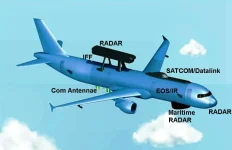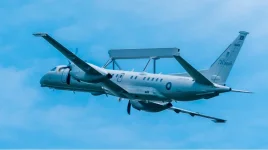- Views: 1K
- Replies: 5
Reports indicate that a risky attempt by the Pakistan Air Force (PAF) to shield its valuable surveillance aircraft by using civilian airliners as cover has failed significantly in the face of sophisticated Indian intelligence and the precision of its S-400 air defence system.
A recent report by Asian News International (ANI) states that the Indian Air Force (IAF) conducted a highly coordinated military action, codenamed 'Operation Sindoor,' inflicting substantial damage on the Pakistan Air Force (PAF).
During this operation, key PAF resources were targeted. This included two Saab 2000 Airborne Early Warning and Control (AEW&C) aircraft; one was reportedly downed far within Pakistan, and the other was destroyed at the Bholari air base.
Indian satellites and Airborne Warning and Control Systems (AWACS) monitored these strikes, which highlighted weaknesses in Pakistan's air defence, especially its tactic of trying to protect valuable military aircraft by using commercial flight paths for cover. These AEW&C aircraft are crucial for providing an 'eye in the sky', offering extensive surveillance and command capabilities during air operations.
According to the ANI report, the Pakistan Air Force (PAF), reportedly concerned about India’s sophisticated S-400 air defence system, employed a high-risk strategy. To safeguard its Saab 2000 AEW&C aircraft, which are essential for aerial surveillance and operational command, the PAF allegedly tried to fly one of these planes close to or within routes used by commercial airlines in Pakistani airspace.
This action was likely an attempt to use civilian air traffic as a shield to prevent Indian attacks, due to the danger of harming non-combatants. Nevertheless, this approach proved unsuccessful. The Indian Air Force, with its precise targeting abilities enhanced by the S-400 system, managed to detect and disable one Saab 2000 AEW&C aircraft at a distance of roughly 280 to 315 kilometres inside Pakistan.
The other Saab 2000 AEW&C aircraft was eliminated on the ground when a cruise missile struck a hangar at the Bholari air base. This hangar also reportedly contained three to four fighter jets manufactured in Western countries. The strike resulted in significant damage, and reports suggest that the PAF has not yet started clearing the debris, which points to the extensive nature of the destruction.
Losing two AEW&C aircraft, which are vital for maintaining awareness of the battlefield situation and coordinating air operations in real time, is a major blow to Pakistan's air defence capacity.
The Indian Air Force's success in tracking and destroying the airborne Saab 2000, even though it was reportedly flying near commercial aircraft, highlights the advanced level of India’s military technology and intelligence gathering.
The S-400 air defence system, renowned for its capability to hit targets accurately at long distances and its sophisticated radar systems, was reportedly crucial in neutralising the airborne AEW&C. This event demonstrated the S-400's ability to effectively engage important military targets, even when civilian aircraft are in proximity.
Further reports from 'Operation Sindoor' indicate that another PAF air base in Pakistan's Punjab region was also targeted. Three missiles reportedly hit various sections of the runways at this base, preventing aircraft from taking off or landing for a minimum of eight hours.
The success of these strikes was carefully observed by Indian satellites and AWACS aircraft, which provided continuous information and supported the precise execution of the operation.
The alleged attempt by the Pakistan Air Force to use commercial airliners for protection raises significant questions regarding the safety of civilian flights in conflict zones. Placing military aircraft close to civilian ones could have put innocent people at risk, an action that is consistence with unprofessional nature of Pakistan military establishment.
Such actions could be seen as contrary to international norms that emphasize the protection of civilian lives and infrastructure during armed conflicts. The reported failure of this strategy further emphasizes the Indian Air Force's advanced operational capabilities and its capacity for highly accurate strikes designed to reduce risks to civilian populations and property.
The loss of two Saab 2000 AEW&C aircraft – one destroyed while airborne and another on the ground – in addition to several fighter jets, substantially diminishes the Pakistan Air Force's ability to conduct operations. This reduction in critical military assets is expected to negatively affect Pakistan's capacity to detect and react to air-based threats, thereby weakening its air defence posture for the foreseeable future.


